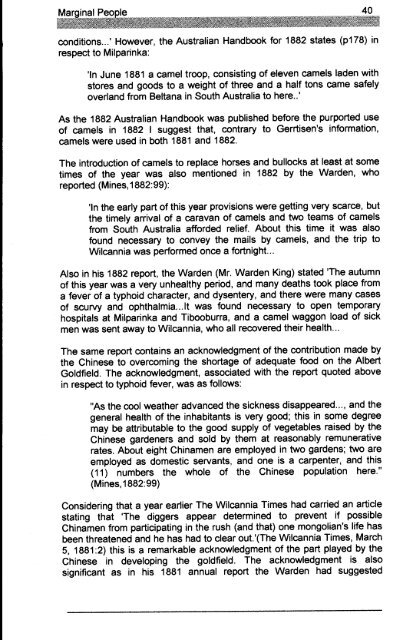Adec Preview Generated PDF File - The Sydney eScholarship ...
Adec Preview Generated PDF File - The Sydney eScholarship ...
Adec Preview Generated PDF File - The Sydney eScholarship ...
You also want an ePaper? Increase the reach of your titles
YUMPU automatically turns print PDFs into web optimized ePapers that Google loves.
conditions.. .' However, the Australian Handbook for 1882 states (p178) in<br />
respect to Milparinka:<br />
'In June 1881 a camel troop, consisting of eleven camels laden with<br />
stores and goods to a weight of three and a half tons came safely<br />
overland from Beltana in South Australia to here.. '<br />
As the 1882 Australian Handbook was published before the purported use<br />
of camels in 1882 I suggest that, contrary to Gerrtisen's information,<br />
camels were used in both 1881 and 1882.<br />
<strong>The</strong> introduction of camels to replace horses and bullocks at least at some<br />
times of the year was also mentioned in 1882 by the Warden, who<br />
reported (Mines,1882:99):<br />
'In the early part of this year provisions were getting very scarce, but<br />
the timely arrival of a caravan of camels and two teams of camels<br />
from South Australia afforded relief. About this time it was also<br />
found necessary to convey the mails by camels, and the trip to<br />
Wilcannia was performed once a fortnight...<br />
Also in his 1882 report, the Warden (Mr. Warden King) stated '<strong>The</strong> autumn<br />
of this year was a very unhealthy period, and many deaths took place from<br />
a fever of a typhoid character, and dysentery, and there were many cases<br />
of scurvy and ophthalmia...It was found necessary to open temporary<br />
hospitals at Milparinka and Tibooburra, and a camel waggon load of sick<br />
men was sent away to Wilcannia, who all recovered their health...<br />
<strong>The</strong> same report contains an acknowledgment of the contribution made by<br />
the Chinese to overcoming the shortage of adequate food on the Albert<br />
Goldfield. <strong>The</strong> acknowledgment, associated with the report quoted above<br />
in respect to typhoid fever, was as follows:<br />
"As the cool weather advanced the sickness disappeared... , and the<br />
general health of the inhabitants is very good; this in some degree<br />
may be attributable to the good supply of vegetables raised by the<br />
Chinese gardeners and sold by them at reasonably remunerative<br />
rates. About eight Chinamen are employed in two gardens; two are<br />
employed as domestic servants, and one is a carpenter, and this<br />
(11) numbers the whole of the Chinese population here."<br />
(Mines, 1882:99)<br />
Considering that a year earlier <strong>The</strong> Wilcannia Times had carried an article<br />
stating that '<strong>The</strong> diggers appear determined to prevent if possible<br />
Chinamen from participating in the rush (and that) one mongolian's life has<br />
been threatened and he has had to clear out.'(<strong>The</strong> Wilcannia Times, March<br />
5, 1881:2) this is a remarkable acknowledgment of the part played by the<br />
Chinese in developing the goldfield. <strong>The</strong> acknowledgment is also<br />
significant as in his 1881 annual report the Warden had suggested




